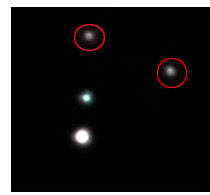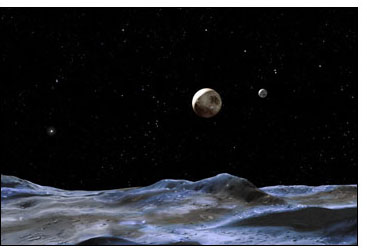WASHINGTON, Nov. 2 -- Using NASA's Hubble Space Telescope to view the ninth planet in our solar system, astronomers discovered Pluto may have not one, but three moons. If confirmed, the discovery of the two new moons could offer insights into the nature and evolution of the Pluto system as well as that of the the entire Kuiper Belt, the vast region of icy, rocky bodies beyond Neptune's orbit where Pluto resides.
"If, as our new Hubble images indicate, Pluto has not one, but two or three moons, it will become the first body in the Kuiper Belt known to have more than one satellite," said Hal Weaver of the Johns Hopkins Applied Physics Laboratory in Laurel, Md. He is co-leader of the team that made the discovery. 
The two new moons are shown circled in red. Pluto is the large object at the bottom and Charon, previously thought to be Pluto's only moon, is the small bluish object above Pluto. (Photo: NASA, ESA, H. Weaver [JHU/APL], A. Stern [SwRI] and the HST Pluto Companion Search Team)
Pluto was discovered in 1930. Charon, Pluto's only confirmed moon, was discovered by ground-based observers in 1978. The planet resides about 3 billion miles from the sun.
"Our result suggests other bodies in the Kuiper Belt may have more than one moon. It also means planetary scientists will have to take these new moons into account when modeling the formation of the Pluto system," said research team co-leader Alan Stern of the Southwest Research Institute in Boulder, Colo.
The candidate moons, provisionally called S/2005 P1 and S/2005 P2, were observed approximately 27,000 miles away from Pluto. The objects are roughly two to three times as far from Pluto as Charon. 
This artist's rendering shows the Pluto system from the surface of one of the candidate moons. The other members of the Pluto system are just above the putative moon's surface. Pluto is the large disk at center, right. Charon, the system's only confirmed moon, is the smaller disk to the right of Pluto. The other candidate moon is the bright dot on Pluto's far left. (Illustration: NASA, ESA and G. Bacon [STSc]
The team plans to make follow-up Hubble observations in February to confirm the newly discovered objects are truly Pluto's moons. Only after confirmation will the International Astronomical Union consider names for the two candidate moons.
The Hubble's advanced camera for surveys observed the two new candidate moons on May 15, 2005. The candidates are roughly 5000 times fainter than Pluto. Three days later, Hubble looked at Pluto again. The two objects were still there and appeared to be moving in orbit around the planet.
Team members say they looked long and hard for other potential moons around the planet. "These Hubble images represent the most sensitive search yet for objects around Pluto," said team member Andrew Steffl of the Southwest Research Institute. "It is unlikely that there are any other moons larger than about 10 miles across in the Pluto system," he said.
For information about this discovery, visit: http://hubblesite.org
Hubble searches for oxygen on the moon
In addition to discovering new planetary bodies, the Hubble Telescope has also been put to use studying Earth's moon. The Hubble is looking for resources there essential to survival, such as oxygen, as part of President George W. Bush's Vision for Space Exploration, which could someday mean human outposts on the moon and human exploration of Mars.
Scientists enlisted Hubble's help because they needed to use ultraviolet (UV) light to help find signatures of lunar materials enriched in oxygen. Since UV light is blocked by gases in the Earth's atmosphere, ground-based telescopes can't use it to observe the lunar surface. But Hubble, orbiting above Earth's atmosphere, can see in UV light. The telescope mapped variations in reflections of UV light off the lunar surface to search for specific mineral fingerprints. 
The color composite focuses on the 26-mile-diameter Aristarchus impact crater and uses ultraviolet- to visible-color-ratio information to accentuate differences that are potentially diagnostic of ilmenite-bearing materials as well as volcanic glasses and other materials. (Photo: NASA/ESA/HST Moon Team)
NASA officials say a preliminary assessment of the Hubble observations pinpoints possible locations of ilmenite, a titanium oxide rich in oxygen, at the Apollo 17 landing site, which astronauts had collected when they last walked there in December 1972. Ilmenite is a potentially key resource because it contains easily extracted oxygen, which can be used for breathing and for rocket fuel. Since the moon doesn't have an atmosphere, scientists must hunt for oxygen in lunar soils if humans are to learn to live off the "land."
The telescope first observed two Apollo landing sites where oxygen-bearing minerals were found, then viewed an area that astronauts have never visited: the Aristarchus crater, created when an asteroid hit the moon millions of years ago, and the adjacent Schroter's Valley, or rille, where lava once flowed and which possibly contains additional oxygen-bearing material. Scientists compared the UV and visible views of the two Apollo sites with the Aristarchus and Schroter's Valley regions. The reflected UV light from Aristarchus and Schroter's Valley indicated the possible presence of titanium oxides as well as other materials. Unravelling the complete story at Aristarchus will take more detailed analysis by the Hubble moon team over the next several months, researchers say.
The moon is a difficult target for Hubble because it moves across the sky faster than Hubble can track it and is very dim in UV light. The observations required steady, precise, as well as long exposures to search for the resources. In spite of these challenges, scientists say Hubble was able to image all of its targets, and early results show that it can detect ilmenite at the Apollo 17 site from 248,000 miles away.
The Hubble Space Telescope is a project of international cooperation between NASA and the European Space Agency. The Space Telescope Science Institute in Baltimore conducts Hubble science operations. The institute is operated for NASA by the Association of Universities for Research in Astronomy Inc. in Washington.
For more information about Hubble's moon exploration, visit: http://hubblesite.org